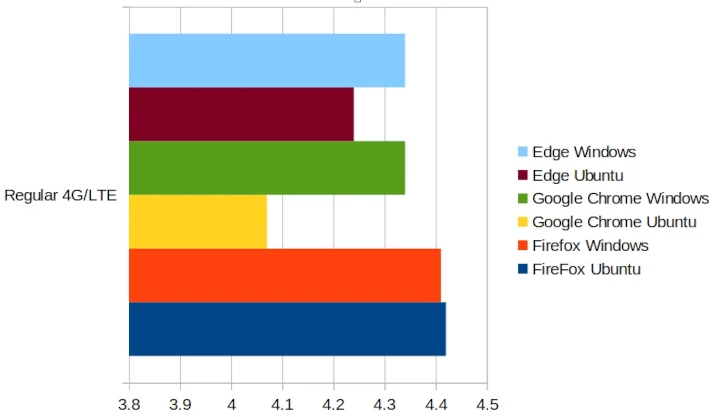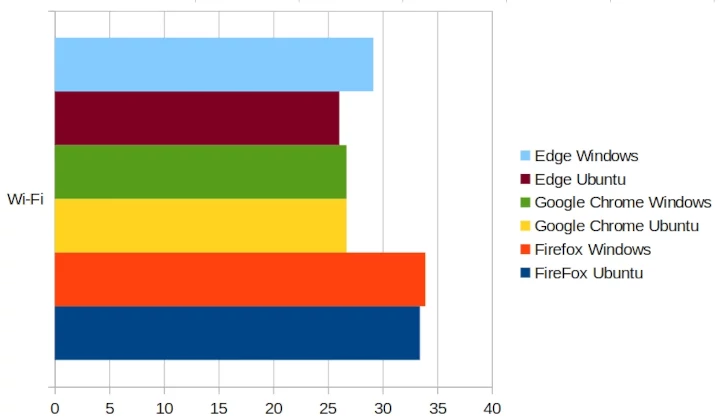TL;DR
Throttling browser speed is usually done by developers who want to know how their website (or app) behaves under those circumstances.
Today there are two browser engines available, each with their own throttling options. The Gecko rendering engine used in Firefox and the Blink rendering engine as used in Chromium based browsers like Google Chrome and Microsoft Edge.
Firefox has a limited number of options. These options specify the "advertised" Internet speed. With Chrome and Edge you can indicate the desired maximum "true" internet speed yourself.
Firefox seems to throttle the interspeed most accurately (when you realise that the throtteld speed given is the "advertised" internet speed).
Contents
Introduction
The first test done for the ultimate speed test was with a throtteld browser.
At that time there were too many uncertainties about the accuracy of speed tests.
Today it is clear which speed tests have the smallest standard deviation and what their deviation is from the advertised speed.
As a result, it should now be possible to accurately determine the throttled speed of an internet browser.
Method of measurement
Only one speed test is used for this test. Namely SpeedOf.me. This is because it is clear what this speed test measures (namely your true internet speed), it worked fine in the first test and because this speed test has a small standard deviation at different speeds.
The Firefox browser supports a limited number of throtteld speeds. Hence for this test we use the following speeds:
- 4 Mbps (Regular 4G/LTE)
- 30 Mbps (Wi-Fi)
Browsers to test
For this test the following browsers will be tested:
- Mozilla Firefox Snap for Ubuntu, version 111.0 (64-bit) (Ubuntu Jammy)
- Firefox, version 111.0 (64-bit) (Windows 11)
- Google Chrome, version 111.0.5563.64 (Official Build) (64-bit) (Ubuntu Jammy)
- Google Chrome, version 111.0.5563.65 (Officiële build) (64-bits) (Windows 11)
- Edge, version 111.0.1661.44 (Official build) (64-bit) (Ubuntu Jammy)
- Edge, version 111.0.1661.44 (Officiële build) (64-bits) (Windows 11)
The results
The following download speeds has been measured. Note that all values in Mbps.
- Firefox Ubuntu 4 Mbps (Regular 4G/LTE)
- SpeedOf.me: 4.3, 4.49, 4.42 Mbps. Median 4.42 Mbps, standard deviation: 0.10
- SpeedOf.me (max): 5.25, 5.27, 5.28 Mbps. Median 5.27 Mbps, standard deviation: 0.02
- Firefox Ubuntu 30 Mbps (Wi-Fi)
- SpeedOf.me: 33.42, 33.5, 33.37 Mbps. Median 33.42 Mbps, standard deviation: 0.07
- SpeedOf.me (max): 49.73, 50.77, 50.46 Mbps. Median 50.46 Mbps, standard deviation: 0.53
- Firefox Windows 4 Mbps (Regular 4G/LTE)
- SpeedOf.me: 4.41, 4.27, 4.7 Mbps. Median 4.41 Mbps, standard deviation: 0.22
- SpeedOf.me (max): 5.03, 5.18, 5.13 Mbps. Median 5.13 Mbps, standard deviation: 0.08
- Firefox Windows 30 Mbps (Wi-Fi)
- SpeedOf.me: 34.01, 33.29, 33.91 Mbps. Median 33.91 Mbps, standard deviation: 0.39
- SpeedOf.me (max): 50.11, 50.5, 50.3 Mbps. Median 50.3 Mbps, standard deviation: 0.20
- Google Chrome Ubuntu 4 Mbps
- SpeedOf.me: 4.24, 4.07, 4.06 Mbps. Median 4.07 Mbps, standard deviation: 0.10
- SpeedOf.me (max): 4.25, 4.24, 4.25 Mbps. Median 4.25 Mbps, standard deviation: 0.01
- Google Chrome Ubuntu 30 Mbps
- SpeedOf.me: 26.83, 26.7, 22.5 Mbps. Median 26.7 Mbps, standard deviation: 2.46
- SpeedOf.me (max): 27.6, 28.25, 28.2 Mbps. Median 28.2 Mbps, standard deviation: 0.36
- Google Chrome Windows 4 Mbps
- SpeedOf.me: 4.34, 4.35, 4.34 Mbps. Median 4.34 Mbps, standard deviation: 0.01
- SpeedOf.me (max): 4.34, 4.37, 4.35 Mbps. Median 4.35 Mbps, standard deviation: 0.02
- Google Chrome Windows 30 Mbps
- SpeedOf.me: 28.16, 29.42, 28.91 Mbps. Median 28.91 Mbps, standard deviation: 0.63
- SpeedOf.me (max): 28.91, 29.58, 29.16 Mbps. Median 29.16 Mbps, standard deviation: 0.34
- Edge Ubuntu 4 Mbps
- SpeedOf.me: 4.2, 4.24, 4.24 Mbps. Median 4.24 Mbps, standard deviation: 0.02
- SpeedOf.me (max): 4.21, 4.25, 4.25 Mbps. Median 4.25 Mbps, standard deviation: 0.02
- Edge Ubuntu 30 Mbps
- SpeedOf.me: 26.27, 23.92, 26,04 Mbps. Median 26.04 Mbps, standard deviation: 1.30
- SpeedOf.me (max): 26.74, 29.62, 26,54 Mbps. Median 26.74 Mbps, standard deviation: 1.72
- Edge Windows 4 Mbps
- SpeedOf.me: 4.37, 4.34, 4.29 Mbps. Median 4.34 Mbps, standard deviation: 0.04
- SpeedOf.me (max): 4.37, 4.37, 4.38 Mbps. Median 4.37 Mbps, standard deviation: 0.01
- Edge Windows 30 Mbps
- SpeedOf.me: 29.15, 29,05, 29.15 Mbps. Median 29.15 Mbps, standard deviation: 0.06
- SpeedOf.me (max): 29.29, 29.1, 29.39 Mbps. Median 29.29 Mbps, standard deviation: 0.15
The measurements of the normal speed test in chart are shown below:


Conclusions
Based on the results (and graphs) above it is concluded that throttling works extremly well. Firefox uses more or less the true internet speed. When you select Wi-Fi which is similar to 30 Mbps, then Firefox gives you 12% more. This is also done by your ISP. Hence the results are in line with what you expect.
Chromium based browsers like Google Chrome and Microsoft Edge are more flexibel in defining the maximum download speed. These browsers don't add an extra 12%, although at a lower speed (4 Mbps) it is more than at a higher speed (30 Mbps).
Hence the Firefox browser seems to have a more accurate throttling than Chromium based browsers, however with Chromium based browsers you are free to define any maximum download speed.